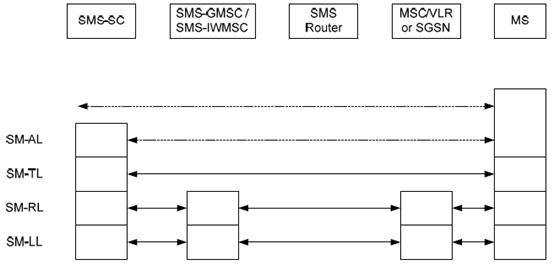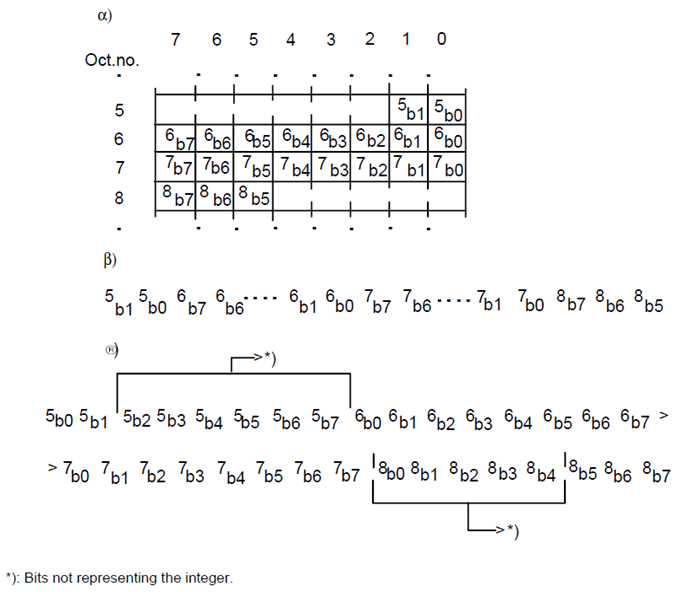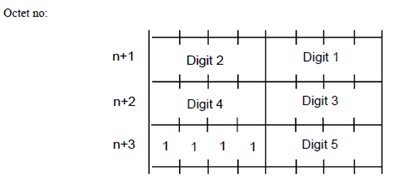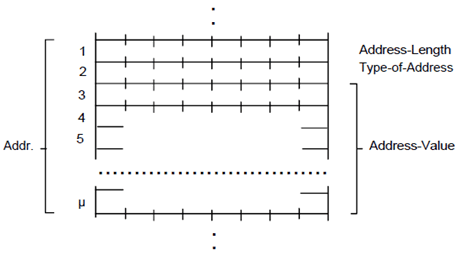Content for TS 23.040 Word version: 18.0.0
0…
3…
3.3…
4…
8…
9…
9.2…
9.2.2.2…
9.2.2.3…
9.2.3…
9.2.3.12…
9.2.3.24
9.2.3.24.1…
9.2.3.24.10…
9.2.3.24.10.1.12…
9.2.3.24.10.2…
9.2.3.24.11…
9.2.3.25…
9.3…
10…
10.1.1…
10.1.3…
10.1.5…
10.1.7…
10.1.9…
10.1.11…
10.1.13…
10.1.15…
10.1.17…
10.2
10.2.1…
10.2.3…
10.2.5…
10.2.7…
10.3
11…
A…
C
C.1…
C.3…
C.5…
C.7…
C.9…
C.11…
C.13…
C.15…
D…
E…
F…
G…
G.2…
G.6
G.7
H…
I…
J…
K…
9 Protocols and protocol architecture
9.1 Protocol element features
9.1.1 Octet and Bit transmission order
9.1.2 Numeric and alphanumeric representation
...
...
9 Protocols and protocol architecture p. 44
The protocol layers of the SMS are structured as shown in Figure 7.

The present document specifies the protocol at the SM-TL, the service offered by the SM-TL at the MS and the SC, and the service offered by the SM-RL at the SC.
Note that while normally SM-TL terminates at the SC in SM MO, the SMS-IWMSC may inspect TP-DA in SMS-SUBMIT for the purpose of checking the existence of an SMS interworking agreement (see clause 8.2.2).
9.1 Protocol element features p. 45
9.1.1 Octet and Bit transmission order p. 45
The octets are transmitted according to their individual numbering; the octet with the lowest number being transmitted first. The bits within each octet are transmitted according to their individual numbering also; the bits with the lowest internal number being transmitted first.
9.1.2 Numeric and alphanumeric representation p. 45
For parameters within the TPDUs, there are four ways of numeric representation: Integer representation, octet, semi-octet and alphanumeric representation.
9.1.2.1 Integer representation p. 45
Wherever the bits from a number of octets, complete or in fractions, are to represent an integer, the interpretation shall be according to the following:
- Between octets: the octets with the lowest octet numbers shall contain the most significant bits, i.e. the byte order shall be big endian.
- Within an octet: the bits with the highest bit numbers shall be the most significant.

Figure 8: 21 bits from the octets 5, 6, 7, and 8 in a short message α) shall represent an integer as shown in β), and shall be transmitted in an order as shown in Γ)
(⇒ copy of original 3GPP image)
(⇒ copy of original 3GPP image)
9.1.2.2 Octet representation p. 46
A field which is octet represented, shall always consist of a number of complete octets. Each octet within the field represents one decimal digit. The octets with the lowest octet numbers shall contain the most significant decimal digits.
9.1.2.3 Semi-octet representation p. 46
A field which is semi-octet represented, shall consist of a number of complete octets and - possibly - one half octet. Each half octet within the field represents one decimal digit. The octets with the lowest octet numbers shall contain the most significant decimal digits. Within one octet, the half octet containing the bits with bit numbers 0 to 3, shall represent the most significant digit.
In the case where a semi-octet represented field comprises an odd number of digits, the bits with bit numbers 4 to 7 within the last octet are fill bits and shall always be set to "1111".
If a mobile receives an address field containing non-integer information in the semi-octets other than "1111" (e.g. 1110) it shall display the semi-octet as the representation given in TS 24.008 under "called BCD number", viz 1010="*", 1011="#", 1100="a", 1101="b", 1110="c". In the event of a discrepancy between the values quoted here and the values specified in TS 24.008 then TS 24.008 shall take precedence. If a mobile receives "1111" in a position prior to the last semi-octet then processing shall commence with the next semi-octet and the intervening semi-octet shall be ignored.
Within each semi octet, the bits with the highest bit numbers shall be the most significant.
Below is given an example:

9.1.2.4 Alphanumeric representation p. 47
A field which uses alphanumeric representation shall consist of a number of 7-bit characters represented as the default alphabet defined in TS 23.038.
9.1.2.5 Address fields p. 47
Address fields used by SM-RL are specified in TS 24.011 and TS 29.002.
Each address field of the SM-TL consists of the following sub-fields: An Address-Length field of one octet, a Type-of-Address field of one octet, and one Address-Value field of variable length; as shown below:

The Address-Length field is an integer representation of the number of useful semi-octets within the Address-Value field, i.e. excludes any semi octet containing only fill bits.
The Type-of-Address field format is as follows:

Type-of-number:
Bits 6 5 4
0 0 0 Unknown 1)
0 0 1 International number 2)
0 1 0 National number 3)
0 1 1 Network specific number 4)
1 0 0 Subscriber number 5)
1 0 1 Alphanumeric,
(coded according to TS 23.038
GSM 7-bit default alphabet)
1 1 0 Abbreviated number
1 1 1 Reserved for extension
The MS shall interpret reserved values as "Unknown" but shall store them exactly as received.
The SC may reject messages with a type of number containing a reserved value or one which is not supported.
Reserved values shall not be transmitted by an SC conforming to this version of the specification.
- "Unknown" is used when the user or network has no a priori information about the numbering plan. In this case, the Address-Value field is organized according to the network dialling plan, e.g. prefix or escape digits might be present.
- The international format shall be accepted also when the message is destined to a recipient in the same country as the MSC or as the SGSN.
- Prefix or escape digits shall not be included.
- "Network specific number" is used to indicate administration/service number specific to the serving network, e.g. used to access an operator.
- "Subscriber number" is used when a specific short number representation is stored in one or more SCs as part of a higher layer application. (Note that "Subscriber number" shall only be used in connection with the proper PID referring to this application).
Bits 3 2 1 0
0 0 0 0 Unknown
0 0 0 1 ISDN/telephone numbering plan (E.164 [17]/E.163 [18])
0 0 1 1 Data numbering plan (X.121)
0 1 0 0 Telex numbering plan
0 1 0 1 Service Centre Specific plan 1)
0 1 1 0 Service Centre Specific plan 1)
1 0 0 0 National numbering plan
1 0 0 1 Private numbering plan
1 0 1 0 ERMES numbering plan (ETSI DE/PS 3 01-3)
1 1 1 1 Reserved for extension
All other values are reserved.
- "Service Centre specific number" is used to indicate a numbering plan specific to External Short Message Entities attached to the SMSC.
- Applies only to addressing at the SM-TL.